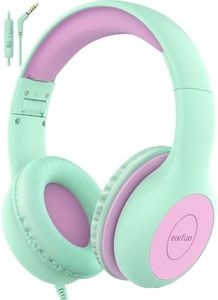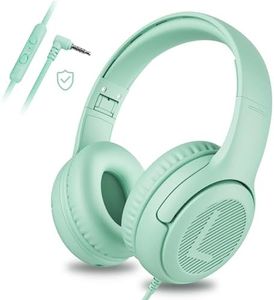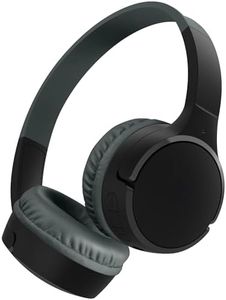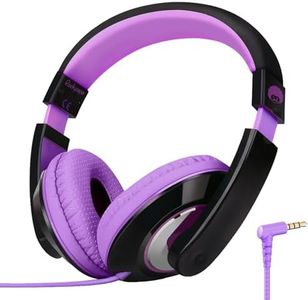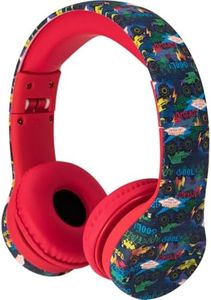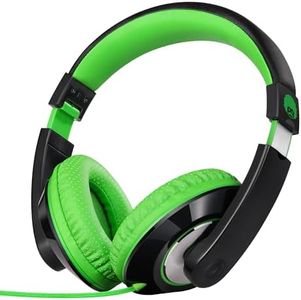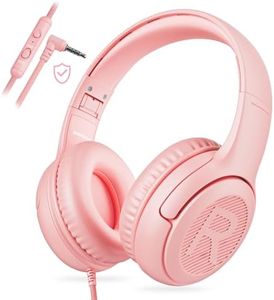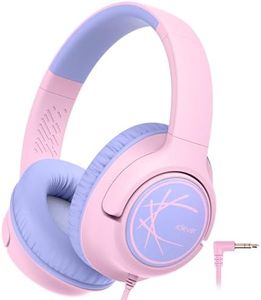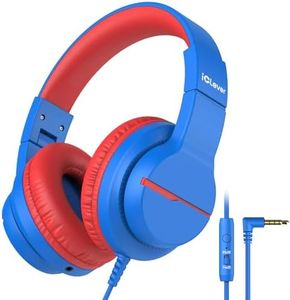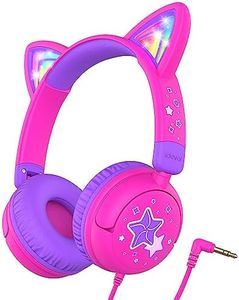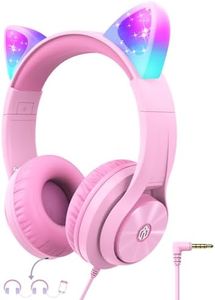We Use CookiesWe use cookies to enhance the security, performance,
functionality and for analytical and promotional activities. By continuing to browse this site you
are agreeing to our privacy policy
10 Best Wired Headphones For Kids
From leading brands and best sellers available on the web.Buying Guide for the Best Wired Headphones For Kids
When choosing wired headphones for kids, your main priorities should be safety, comfort, durability, and sound quality. Kids' headphones are different from regular headphones because they need to be safe for young ears and sturdy enough to survive daily use. The right headphones will protect your child’s hearing, feel comfortable during long listening sessions, and withstand some rough handling. Look for simple controls and a design your child will enjoy wearing.Volume LimitingVolume limiting is a built-in feature that caps the maximum loudness the headphones can reach, usually around 85 dB. This is critical for kids, as their ears are more sensitive and exposure to loud sounds can cause permanent hearing damage. When evaluating this feature, check if the headphones strictly enforce the limit or if it can be accidentally overridden. If the headphones will be used by young children or in settings where you can’t monitor them closely, make sure the volume limiting is always active and can’t be bypassed.
Fit and ComfortFit and comfort refer to how well the headphones sit on a child’s head and their overall feel during use. Comfortable, lightweight headphones with soft ear cushions help prevent ear fatigue during long listening periods. Headphones that are adjustable can accommodate a child’s growth and fit different head sizes securely. When choosing, consider your child’s age—smaller and lighter models are ideal for younger kids, while older children can handle slightly larger designs. Always prioritize a secure, gentle fit to prevent discomfort or the headphones slipping off easily.
Durability and Build QualityDurability and build quality relate to how well the headphones can withstand drops, twists, and the general rough use that kids often deliver. Look for headphones with reinforced cables (especially those with tangle-free or braided cords), sturdy connectors, and flexible, bendable headbands that won’t break easily. If your kid tends to be rough on things, prioritize models designed specifically for kids, as these are generally built tougher. Detachable or replaceable parts can also extend the life of the headphones.
Sound QualitySound quality describes how clear and pleasant the audio sounds through the headphones. While audiophile quality isn’t essential for kids, you still want sound that’s not too tinny or muddy. Look for headphones that produce a balanced sound, because excessively boosted bass or treble can be tiring or uncomfortable, especially at lower volume limits. If your child listens to music, audiobooks, or watches movies, try to pick headphones reviewed positively for clarity and detail that's suitable for these uses.
Cable Length and TypeThe cable length and type affect how easily a child can move around while using the headphones and how likely the cable is to tangle or get damaged. Shorter cables (around 1 to 1.2 meters) are generally safer for kids, reducing the risk of tangling or accidents, while longer cables might be better for stationary use, such as with a computer. Choose a cable that’s reinforced and flexible to withstand regular bending. Some headphones feature detachable or tangle-resistant cords, which can be handy for kids who move around a lot.
Adjustability and SizeAdjustability and size refer to whether the headphones can grow with your child and fit comfortably as they get older. Look for adjustable headbands and rotating ear cups, which allow the headphones to adapt to different head shapes and sizes. For younger kids, prioritize smaller, lightweight designs intended for their age group. For older or rapidly growing kids, choose headphones that offer a wide adjustment range to maximize usage over several years.
Design and AestheticsDesign and aesthetics are about how the headphones look and whether your child finds them appealing. Many kids are motivated by colorful designs, fun patterns, or characters they like, which can encourage them to use the headphones consistently. More importantly, choose designs that are free of small, easily detachable parts to reduce choking hazards for younger children. If your child has a preference, involving them in the selection process can help ensure they’re happy with the choice.

![[2 Pack] i](https://images-proxy.bestreviews.guide/lfmM030Z8lfvkyfdIKnF19z9F-s=/0x300/https://m.media-amazon.com/images/I/41krBBA9geL._AC_CX679_.jpg)

